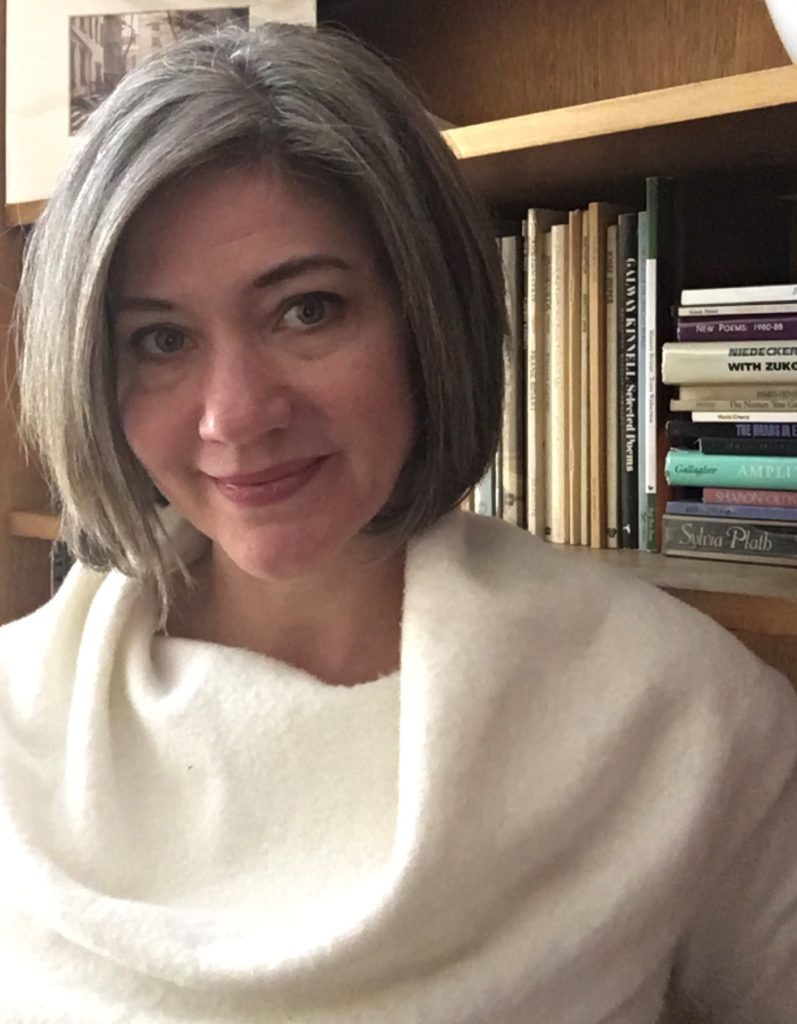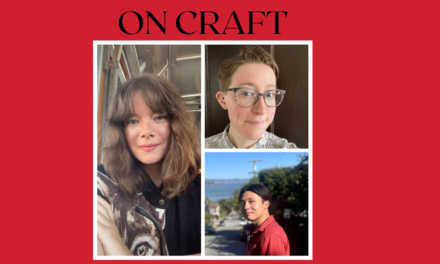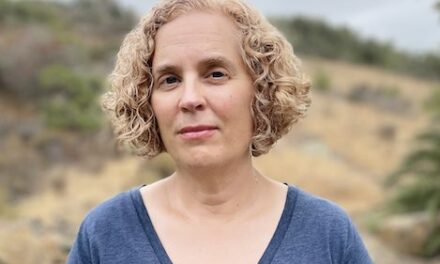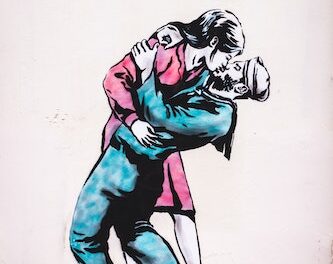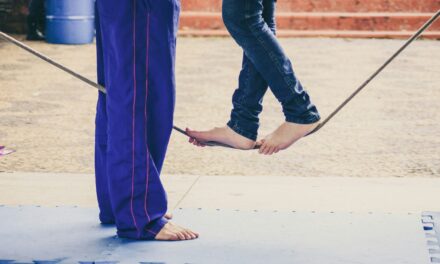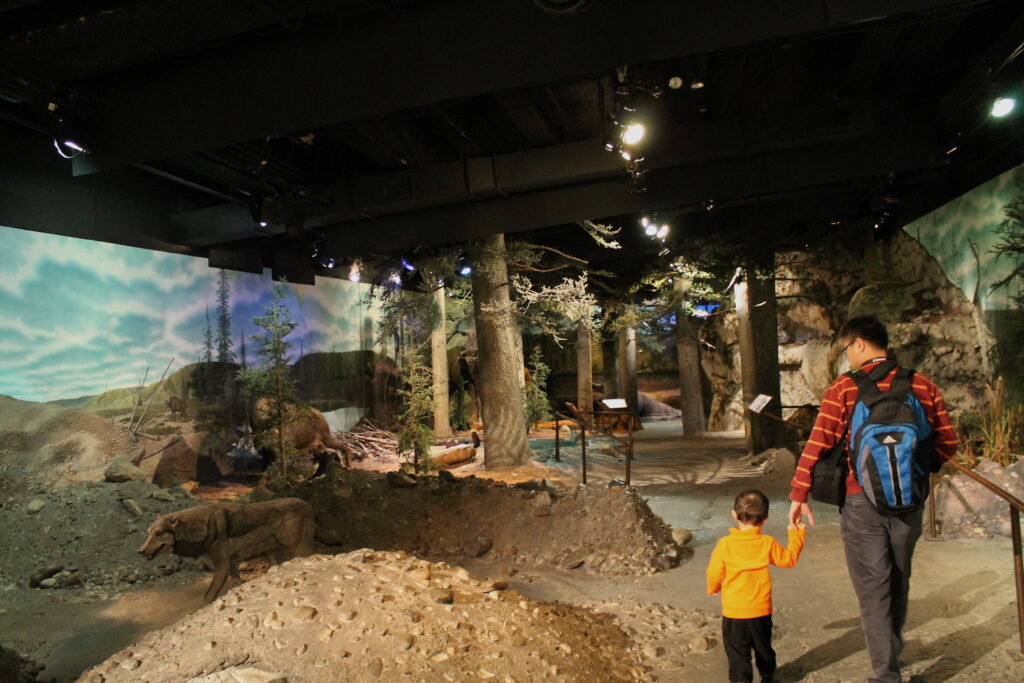
Assistant Editor Connor Yeck: At a recent visit to the Cincinnati Museum Center, I walked through a replica Ice Age ecosphere. A small stream ran beside a loose-pebble pathway, while chilled air blew somewhere behind a stand of fiberglass pines that melted into the painted vista of prehistoric Ohioan grasslands. Alongside plastic models of extinct musk ox and dire wolves were glass-encased fragments of petrified wood, mastodon tusks, and wire-strung skeletons, each reconstructed megafauna an “astounding crate full of air,” to borrow from Seamus Heaney.
I found myself leaving with my fair share of poems from those few hours in the museum: about moon rocks, street cars, and cave bears; models, miniatures, and replicas. I’ve long been fascinated by the inspiration and even obsession that museums can spur in writers—how they launch us down our own research-driven, curatorial rabbit holes once we leave their presence. But what exactly is it that draws us to these exhibition spaces, real or imagined, and the objects, narratives, and moments they contain? In poems both by recent Cincinnati Review contributors and our poetry editor, I’ve discovered a number of answers.
The mixture of museum realness and performance, a dimension of what I’m calling “museum poetry,” appears in the latest issue of The Cincinnati Review, courtesy of Marianne Boruch’s anatomically arresting “The Taxidermist in the Revered Museum.” From within the museum institution, we witness a unique, almost conversational interaction between taxidermist and subject. And as museum-goers ourselves, we’re reminded we “crave not / just intact but true” when it comes to the art of preservation. In turn, our speaker tracks the intimate process of renewing an outdated biological specimen:
Just relax, the taxidermist might soothe
that forever young red kangaroo,
trading bone for wire to makethe old arsenic-laced stuffing release and relax
into our mode and our fashion,or foam-replace its skeleton completely before she
needles up the time-stopped creaturethat will slip to the ground to lounge dreamy
and casual in pretend desolation,some Outback diorama I would have
loved every Saturday had I been a child in that city.
Before, the young kangaroo was posed “upright-for-eternity,” but now it might “lounge dreamy” in a posture that appeals to “our mode and fashion”; where once we were content to view an unfamiliar creature in all its preserved strangeness (stiff, unnatural, behind glass), now we wish to see it in a more natural state—the push-pull of reality and replica. Boruch’s poem also describes the stunning stillness that museums generate. Through the “time-stopped creature” we might see a grander, more total sort of immobility that poetry pursues—the ability to at last sketch the moment (biological, historical, personal), and to stave off its sudden end.
I’ve also noticed in recent museum poetry a tendency to envision imagined museums—institutions built to house not history, art, or biological specimens but the otherworldly and nearly impossible-to-define. Here, the museum itself acts as a sort of poetic form, or container. We enter a familiar space with expected architecture (gallery, hall, wing, exhibit), but what’s displayed defies reality.
In this vein, Sara Elkamel’s stunning “The Most Unlikely of Passages” in our latest issue envisions a “Museum of Mothers,” a space built on both intimacy and startling doubt:
We start in the sculpture garden, which the curators
have named Sorry for Suffering—You ThinkI’m a Puppy on a Picnic?
We are encouraged to touch the sculptures,
which are all trees. It is not clear if we can also
ask them questions about the suffering—if loveis single strand of goat hair or needle’s eye,
if the cold rust in my chest is omenor birthmark . . .
While we might expect museums to possess a certain clarity in their design—exhibits and displays built to reveal and educate around a central theme—here, that expectation is a challenge. Sculptures are not sculptures, questions remain unasked because of an undefined etiquette, and curators are sensed, yet unseen. By the end of the poem, our speaker is ultimately led “to question / the laws of this place.” Here, an imagined museum raises questions of just how the museum experience is crafted—what are we meant to feel, see, and take with us? What is shown, displayed, and what is withheld?
While the ghostly curators of the Museum of Mothers are felt at a distance, it’s possible to glimpse a more participatory relationship between poet and institution. Such an interaction is deftly explored “In the Museum of Lost Objects,” by the CR’s own poetry editor, Rebecca Lindenberg. In her poem, we witness a flipping of the script when it comes to the expectation that museums must be filled, and structured around objects that are possessed. Rather than exhibitions built on physical presence, we enter an institution founded on what is impossible to reclaim, halls and wings filled with “labels describing what is gone.” Here, the museum undertakes a constant, almost pedagogical mission to demonstrate the multitudinous arrangements that loss might take, from single objects—
A vellum gospel, hidden somewhere long ago
forgotten, would have sat on that pedestal;this glass cabinet could have kept the first
salts carried back from the Levant
—to immense, historical vacancies that test our perception of what can be and has been lost in the passage of cultural time:
To help us comprehend the magnitude
of absence, huge roomslie empty of their wonders—the Colossus,
Babylon’s Hanging Gardens andin this gallery, empty shelves enough to hold
all the scrolls of Alexandria.
Yet this is also a museum that imagines a far more intimate and universal mode of remembrance, and most crucial of all, the poet’s own curatorial voice seeks to both enshrine and withhold:
My love, I’ve petitioned the curator
who has acquired an empty chestrepresenting all the poems you will
now never write. It will be kept with othersin the poet’s gallery. . . .
I hope you don’t mind, but I have kept
a few of your piecesfor my private collection. I think
you know the ones I mean.
I recently had the chance to ask Lindenberg about her poem, and the fascinating potential that museums offer to poetics at large:
Museums are public in nature, and the Museum of Lost Objects showcases its own share of historical loss. Still, the poem ends with the intensely intimate. We glimpse how the personal might be remembered alongside the public, and also what’s ultimately withheld: “I hope you don’t mind, but I have kept / a few of your pieces // for my private collection. I think / you know the ones I mean.” Could you speak on this tension between what is displayed and shared, and what is kept closer?
This is as much a personal story as a conceptual artistic decision. The loss of my late partner Craig Arnold was (at the time) a very public loss—he’d gone missing on a small island in Japan, and in order to keep up the momentum of the search for him, it was necessary to keep his story in the news (NPR, CNN, social media, etc.). That felt important but also incredibly overexposing and anxiety-producing. That withholding gesture at the end refers, for me, to all the things I’ll never publicly discuss about our relationship and our life together, and I think I needed to remind myself that I could and can do that—just to cope with the trauma.
But on a more conceptual level, this poem comes from a book that’s pretty mistrustful of a lot of binary oppositions—emotion and intellect, masculine and feminine, public and private, and crucially, absent and present. Any museum is, I think, by nature, a presence of absence—a reliquary of eras, cultures, individuals. I think I just liked the idea of an imaginary place where what has been lost to time and even memory is somehow looked after.
“Imagined museums” seem to exist as their own form in the poetry landscape. Did you find working within a museum space allowed you to think or create in a particular way that another poetic mode might not have? Did you know from the start this was the form of the poem you’d be writing?
Yeah, sure, I love the idea of the guided tour. I think of the poem as a narrative in which the speaker leads the reader through an imaginary space, pointing out highlights. Also, I’ve spent a lot of time in museums over the years, and for me, as a secular person who loves art and archaeology and history and culture, museums feel like somewhat sacred spaces. I’m compelled by the notion of spaces where shared inheritance is cared for. (I mean, look, in practice, museums are really politically and culturally complicated, but as an idea . . .)
Reading a poem such as “In the Museum of Lost Objects,” it seems the poet becomes a curator themselves— choosing what to display in a finite exhibition space (the available lines on a page). How did you go about selecting what to include? As we witness the museum fill with what’s been lost, did you envision connections based on textures, themes, emotions, or something else?
Oh, I mean, if it feels curated, I’m glad. I think poets are always curators, making choices more than inventing things. But ironically, this piece does feel to me more imagined than most of the other poems I’ve written. I suppose the objects in the so-called museum refer in some sense to things I’ve seen in various other museums. I did want it to have a bit of an Indiana Jones vibe, I think, though not consciously. It’s been years, and I think I can see it now in a way I didn’t before. A bit of that “It belongs in a museum!” conviction. Which, I suppose, also inflects the end—the idea of keeping something from that space, secreting it away; it’s a gesture not of irreverence but, rather, of such attachment to the lost objects in question that the speaker cannot bring herself to give them up, to share them.
What is it that bring us to museums as not only visitors but writers? As glimpsed in these poems and so many more, there’s potential and purpose in the ways such institutions are envisioned, adapted, and redrawn. Whether it be the poet examining a lone historical object in the ekphrastic tradition, or imagining a reality-defying gallery, we find ourselves confronted with the freedom to both curate spaces and explore what’s been curated for us. And what is a poem if not an exhibit, a collection of parts arranged and rearranged, a diorama we wish the reader would linger in front for just a bit longer?

